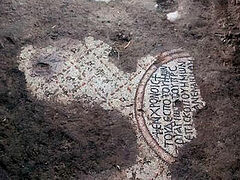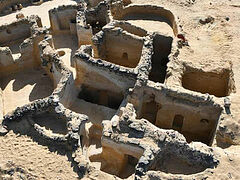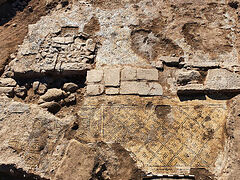Ashdod, Israel, December 3, 2021
A new church recently unearthed in the Holy Land is being hailed as one of the earliest and largest Christian basilicas found in Israel.
It is also one of the most unique, as archaeologists have discovered mass graves all over the territory, including several prominent graves and inscriptions dedicated to deaconesses and other holy women, reports Haaretz.
Parts of the church were first uncovered in Ashdod in 2017, and it has since been fully excavated. A Divine Liturgy was served there in July to pray for the souls of those buried there. His Beatitude Patriarch Theophilos of Jerusalem called on Israeli authorities to protect the church’s remains.
Experts believe the three-nave basilica with multiple attached rooms and chapels was built in the fourth or fifth century and is splendidly adorned with mosaics. They also believe the mass graves are indicative of a plague in the Byzantine Empire and Eurasia in the 6th century—the so-called Plague of Justinian.
“Besides the unusual amount of funerary inscriptions and the prominent place given to women, we found that this church is like one huge cemetery—everywhere we touch we find these strange mounds of skeletons,” says Prof. Alexander Fantalkin from Tel Aviv University, who heads the dig.
The oldest inscription found, which dates itself to 416 AD, reads: “In memory of the priest Gaianos and Severa the deaconess.” The early date suggests the building already existed before the mosaic paving of the nave of the church.
Such memorial inscriptions are not rare for Byzantine churches, but the number of deaconesses and women mentioned in one church is rare, sys Prof. Joseph Patrich from the Hebrew University, who took part in the dig.
The central apse of the church housed the main altar and a tomb—the only tomb in the church not to have been unused. Presumably, this was the tomb of the saint to whom the church was dedicated. Unfortunately, however, no mosaics or inscriptions that could identify the saint have survived.
Fantalkin believes the tomb may have been associated with the one of the four virgin daughters of the Apostle Philip who were gifted with prophecy (Acts 21:9).
There is also a memorial to a “Holy Mother Sophronia,” who could have been the abbess of a nearby convent.
“The Church of the Deaconesses,” as some are calling it today, was destroyed by a huge fire around the year 600, possibly connected with a natural disaster, such as an earthquake, or possibly the Persian invasion in the early 7th century.
Follow us on Facebook, Twitter, Vkontakte, Telegram, WhatsApp, MeWe, and Gab!







